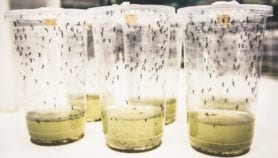By: Bernard Appiah
Send to a friend
The details you provide on this page will not be used to send unsolicited email, and will not be sold to a 3rd party. See privacy policy.
The thorny question of whether improved crop varieties do, in fact, lift peasant farmers out of poverty has been answered positively in a study of groundnut varieties, according to researchers at the International Maize and Wheat Improvement Center (CIMMYT), in Kenya.
Evidence that new technologies improve small farmers’ wellbeing is scarce because the impact of adopting technologies depends on many factors such as the existence of infrastructure, policies and institutions that are often not fully functional in developing countries. For example, technology that increases productivity may not reduce poverty if the farmers do not have access to markets to sell their extra crop.
In addition, some studies have claimed that building capacity is more important than technology for improving livelihoods.
Researchers from CIMMYT selected more than 900 households at random from seven major groundnut growing districts in Uganda and, in 2006, surveyed socioeconomic data and information related to the adoption of improved groundnut varieties. Groundnut is an important crop in Uganda.
Farmers who adopted any of four improved varieties resistant to major pests and diseases — developed by national and international organisations, and released in Uganda between 1999 and 2002 — were compared with non-adopters. The results of the study were published in the October 2011 issue of World Development.
"We found that the adoption of [improved] groundnut varieties significantly increased the net value of income by US$130–254 per hectare," said Menale Kassie, one of the authors of the study. "Adoption of groundnut varieties also significantly reduced poverty as measured by headcount index [the proportion of people below the poverty line] by 7–9 per cent."
In a related study, which has been submitted for publication, Kassie and colleagues found that adopting improved maize varieties also significantly improves rural households’ food security and decreases the extent of poverty.
Richard Edema, a plant pathologist and senior lecturer in the school of agricultural sciences at Makerere University, Uganda, said: "Studies [such as this one] can serve as feedback for agricultural scientists to assess whether new [crop] varieties are making real impacts on farmers’ lives".
Okello David Kalule, head of the Uganda National Groundnut Improvement Programme, said that, although the new groundnut varieties produce superior yields, some farmers are still growing low-yielding varieties. The reasons for this, he said, include poor agricultural extension services and a lack of access to information about the new varieties.
"Local institutions should be strengthened to collectively improve access to seeds, credit, and information to increase both the spread and intensity of adoption," he said.
References
World Development doi: 10.1016/j.worlddev.2011.04.023 (2011)













